|
|
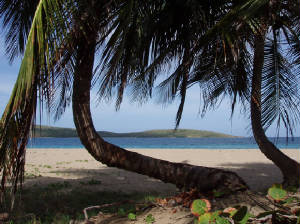
|
| ZONI BEACH, AT THE EAST END OF THE ISLAND |
|
Culebra is a tiny unspoiled island
located 17 miles east of Puerto Rico and 12 miles west of St. Thomas (U.S. Virgin Islands). It measures about 7 miles long
and 4 miles wide. Its total area, including surrounding cays, is 7700 acres.
Lush green mangroves, craggy hills and white powdery beaches line its perimeter, set against a turquoise seashore so pristine
that in places the water seems to give off a neon glow. There are even a few magically phosphorescent bays. On some of its
beaches you might find your footprints the only ones interrupting the perfect continuity of untrammeled sand.
|
| BROWN PELICAN |
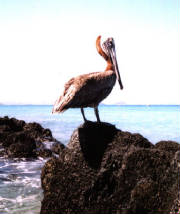
|
Coral
reefs surround the island and a string of offshore keys— all home to brown
pelicans diving for fish, nesting colonies of sooty terns, and cruising grounds for docile iguanas. Leatherbacks and
hawksbill sea turtles nest on some of the more remote beaches. More than 20 percent
of the island and its 23 surrounding cays comprises the Culebra National Wildlife Refuge, protected by the U.S. Fish and Wildlife Service— serving to protect its delicate environment
and discourage the rampant development that has all but ruined other tropical islands. The three largest cays— Culebrita, Cayo Norte, and Luis Peña— are well-known for their undisturbed snorkeling, and scuba diving around the archipelago
is some of the best in the Caribbean.
| TRANQUIL MANGROVES ON ENSENADA HONDA |
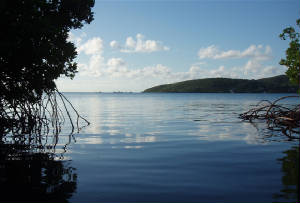
|
On the southern side of Culebra
is a huge inlet, Ensenada Honda, one of the safest hurricane harbors for mariners in the Caribbean. Legendary pirates once
made constant use of this safe haven. Paddling around this serene harbor in a kayak you see cormorants and egrets dotting an islet that is
haven for their nests— no humans and few predators. Turtles and dolphins may surface near your
boat. You float over shallow fields of turtlegrass where starfish feed. Drifting around, you will spot an improbably lean
bird with angular black wings, a forked tail, and an elegant white head— the frigate bird. With
its enormous wingspan it soars endlessly on a single updraft, cocking its head to discern its swimming prey below. Moments
like this best describe what Culebra has to offer.

|
| FLAMENCO BEACH & REEF SYSTEM |
Well protected
by natural rock formations and reefs is the island’s best-known beach, Playa Flamenco, a sparkling crescent-shaped,
2-mile stretch of soft white sand, shallow swimming and gentle surf. It is managed by the U.S. National Park Service and has
picnic tables, open showers, restrooms, beach chairs & umbrellas, and kiosks serving local snacks. A magnet for campers,
Flamenco is rated one of the ten most beautiful beaches in the Western Hemisphere
by the Travel Channel.
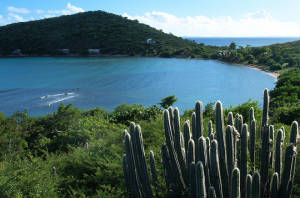
Culebra’s
dozen or so other beaches proudly claim no organized facilities; they are left as nature created them. Visitors bring their
own refreshments and beach gear. Most of these beaches have easily accessible reefs right off the sand. Some of the more remote
beaches can only be reached by hiking paths, others by bicycle, or 4WD. Always an adventure!

|
| AERIAL & HARBOR VIEWS OF THE TOWN OF DEWEY |
Culebra has only one small town, Dewey, where the daily ferries arrive and depart from the “big island”
of Puerto Rico. The town is basically one main street that crosses a bridge, turns a corner and ends at the ferry landing.
It's recently been modernized with newly paved streets, renovated building
facades, a small public square and town hall, and new ferry terminal. Dewey has several gift & craft shops, two grocers,
a liquor store, hardware store, and a half-dozen or so eateries— a couple of waterside cafes,
a pizzeria, deli-bakery, a gourmet snack & food shop, an ice cream stand, and local snack bars. Also in town you'll
find two dive shops, a gasoline pump, a laundry, and a U.S. Post Office. Like we said, small town. The small airport is serviced
by a few local airlines with scheduled flights to and from the main island a few times each day. Charter flights can be arranged
to neighboring islands, like the U.S and British Virgin Islands. Only props fly into Culebra—
the runway is not long enough for jets.
The population
of the island is under 2,000— about two-thirds are native Culebrenses (a
handsome cultural mix of Spaniard and Taíno Indian) and the other third a melange of North Americans and a handful
of Europeans who have made Culebra their “tropical runaway paradise”— some living
there year-round, others seasonally.
The native population
is proud and independent, open and friendly to visitors. People smile and make eye contact when passing on the street: hola, buenos días, buonas tardes. English is spoken virtually everywhere, particularly
by the younger generation who learn it as part of their school curriculum. Local currency is in U.S. dollars. Restaurants range
from beach shack to haute cuisine, yet you can go anywhere dressed no more formally than in shorts and
a T-shirt.
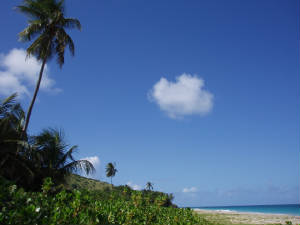
If you are looking for an active
nightlife, resort hotels, tennis, golf, upscale boutiques, jet-set style, and chi-chi restaurants— Culebra is not for
you. If you’re looking for the simple life, for unspoiled natural surroundings, for unwinding on a laid-back vacation
with daily activities like beachcombing & swimming & kayaking & snorkeling at virtually empty beaches; hiking,
reading, and just hanging out in the tropics— well then . . .
|



